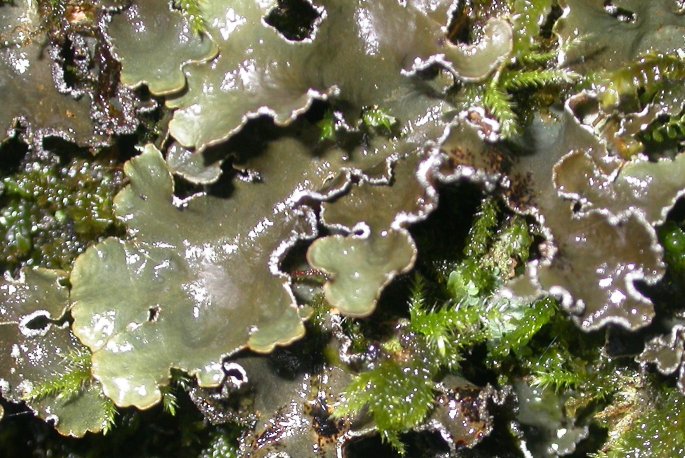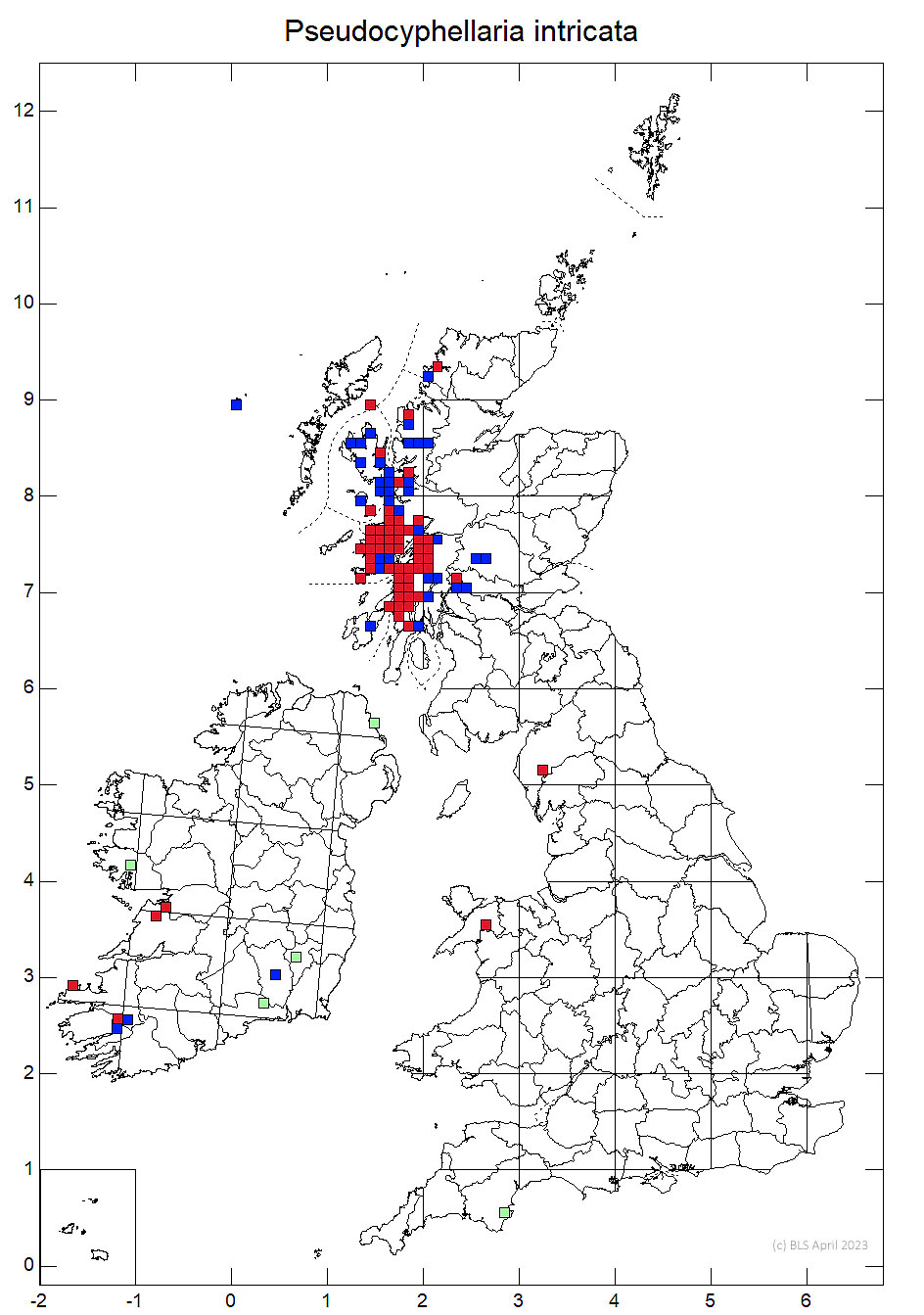Stictina intricata
This is a substantial foliose lichen with, when moist, a brown (café au lait) thallus that becomes grey-brown on drying out. Its surface is smooth, though it may develop rather weak ridges. The purple grey coloured eruptions of soralia along the lobe margins may spread as scattered dots or somewhat more elongated squiggles over the surface of the thallus. They are a prominent feature. It might be mistaken for a Sticta, Nephroma or a Peltigera. The undersurface of Pseudocyphellaria and Sticta is covered in a dense, dark brown stubble of rhizines amongst which are small sunken bald patches, called pseudocyphellae in this species and give it its generic name and the English name of the Americans-the speckle bellies and true cyphellae in Sticta. In practice the differences between theses structures can only be observed with difficulty under a microscope. In Sticta limbata the undersurface and rhizines are much paler in colour and the rhizines less well developed and the lobes tend to be more or less circular in outline and remain discrete. P. intricata develops somewhat elongate overlapping lobes. S. sylvatica smells of fish when wet. Peltigera has large bushy, rather widely spaced rhizines and Nephroma a bare undersurface.

Photo: Ray Woods
PLEASE NOTE. All Pseudocyphellarias appear to be exceptionally rare in
There have been three Pseudocyphellaria species recorded from
It lives on somewhat basic mossy trunks and boulders in woodland or sheltered ravines in humid, oceanic areas. It is usually found in sites with a well-developed Lobarion community. At its one recently known Welsh site it occurs on two ancient maiden ash trees in open woodland. The following relevees of the author describe its associates and habitat.
Relevee 1 SH6420152347 On SSE side of mature maiden Fraxinus excelsior 275cm in circumfrence at centre of relevee at edge of woodland glade on steep SE facing slope at c170m below Ochr y Bwlch to the NW of Llyn Gwynant, Beddgelert, Caernarvonshire VC 49. 12 May 2010. 75cm to 125cm up trunk. 50cm square quadrat. Percentage cover given.
Relevee 2 SH6420152347 On SSE side of mature maiden Fraxinus excelsior 281cm in circumfrence at centre of relevee at edge of woodland glade on steep SE facing slope at c170m below Ochr y Bwlch to the NW of Llyn Gwynant, Beddgelert, Caernarvonshire VC 49. 12 May 2010. 50cm to 100cm up trunk. 50cm square quadrat. Percentage cover given.
| Relevee | 1 | 2 |
| Pseudocyphellaria intricata | 5 | 3 |
| Pterogonium gracile | 25 | 5 |
| Isothecium myosuroides | 5 | 30 |
| Metzgeria furcata | 20 | 3 |
| Isothecium alopecuroides | 1 | 30 |
| Sticta sylvatica | 3 | 1 |
| Pannaria conoplea | 10 | + |
| Porella arboris-vitae | - | 15 |
| Peltigera praetextata | - | 5 |
| Hypnum cupressiforme | - | 3 |
| Normandina pulchella | 1 | - |
| Cladonia sp. | 1 | - |
| Acrocordia gemmata | 1 | - |
| Bark | 30 | 0 |
| Total no. spp. | 10 | 9 |
Within
In Ireland it is rare and confined to the south-west.
In the rest of the world it is rare in the northern hemisphere with records from SW Norway and Madeira (where it is rare) but is more frequent in the southern hemisphere.
The Welsh population of this lichen is Critically Endangered being confined to two mature ash trees and consisting of fewer than 20 individual thalli. Whilst producing a number of vegetative propagules they are small in number compared to the number of spores a regularly fertile lichen could produce (this species has never been found fertile in Europe). The wood is owned and managed by the National Trust, Scheduled as an SSSI and there is a good continuity of mature ash trees in the vicinity though there are very few trees as large as the two it has been located on. Acid rain has probably rendered the bark chemistry of many trees in this wood too acidic for this species. Basic rock outcrops occur close by and could have been a refugium for this lichen if the wood was ever clear felled in the past. The outcrops may currently be too shaded for this species. It is note worthy that the trees supporting this species are at the edge of large glades and the lichen occurs only on the best-lit sides.
Grazing pressure by goats and possibly sheep is currently so high as to suppress all woody regeneration. On the positive side ivy, holly and rhododendron pose no threat. The trees are very large and large canopies may lead to a high risk of wind throw. Tree surgery to lighten the canopies may be desirable.
Due to the extensive population in Scotland the British national conservation status is considered to be Near Threatened. It is a BAP species and is listed on Schedule 42 of the NERC Act in Wales. British populations are considered to be of International Importance.
Leighton, W.A. (1879).The Lichen Flora of
Pentecost, A (1987). The lichen flora of Gwynedd. Lichenologist 19:1-166.
Rose, F. & Coppins, B.J. (1998). Species account 1196/1998 in Lichen Atlas of the British Isles. (ed. M.R.D. Seaward) British Lichen Society,
- Log in to post comments

